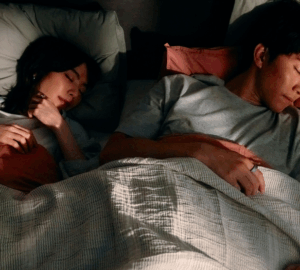In the battle of the sexes, men and women might be playing in different leagues—at least when it comes to sleep patterns, stress levels, and activity habits.
To learn more about how men and women’s habits around sleep, stress, and movement stack up, Oura’s data science team analyzed aggregate, de-identified data from around 45,000 Oura members from March 2023 to March 2024.*
Since Oura is serious about protecting our members’ personal data, we process it to preserve privacy when deriving insights like those contained in this article. For more information about how Oura protects privacy, please see our Privacy Policy.
Here’s what the data uncovered, along with some possible reasons behind these patterns.
Sleep Patterns
According to Oura member data, women generally sleep longer and more efficiently, on average, than men. They also tend to experience greater amounts of deep sleep and REM sleep.

Female Oura members don’t seem to be outliers: Previous research supports this finding that women tend to sleep longer than men.
A combination of biological and hormonal factors is thought to be at play. First, women generally have shorter circadian rhythms, meaning they may feel sleepy earlier and wake up earlier than men. Oura member data supports this too: We’ve found that women are more likely than men to have a morning chronotype!
Women also experience hormonal fluctuations throughout the menstrual cycle, as well as changes during pregnancy and menopause, which can increase the need for sleep as well as worsen its quality. This may lead to women increasing the number of hours to make up for lack of quality.
LEARN MORE: Male and Female Sleep Patterns: How Do They Differ, and Why?
Activity Levels
While male members burn more calories on average than women, women tend to move more during the day, racking up a slightly higher number of steps per day than men.

Men tend to have a higher metabolic rate, meaning they burn more energy at rest. However, typically, previous studies have found that men tend to get more steps in a day compared to women. The higher step count among female Oura members may reflect different types of daily activities or exercise preferences compared to the wider population.
Interestingly, other studies have found that women tend to avoid long stretches of sedentary time compared to men, perhaps explaining why we seeing a higher step count among Oura members. Or maybe women are just better at listening to Oura’s “time to stretch your legs?” prompts!
Stress and Restorative Time
Compared to men, female Oura members tend to spend less time in a “Restored” state and more time in a “Stressed” state, according to Oura’s Daytime Stress Feature.

Across the board, scientific studies have suggested that women tend to be more stressed than men. Researchers hypothesize that women may be more vulnerable to stress, due to societal and evolutionary factors. Plus, women may tend to carry more of a “mental load” than men, which has been linked to greater stress levels.
The lower average restorative time for women also speaks to previously cited research that found women are less likely to stay sedentary for long periods than men. While we’re all for staying active, remember that restorative moments throughout the day can help to balance high levels of stress to improve your resilience!
READ MORE: Which Day of the Week Are Oura Members Most Stressed?
*This analysis included about 27,000 female Oura members and 18,000 male Oura users across the 10 countries with the most Oura members (generally North America and Europe). The time frame spans March 2023 through March 2024, although this does not mean all members have data across this entire time period or the same number of days of data.










